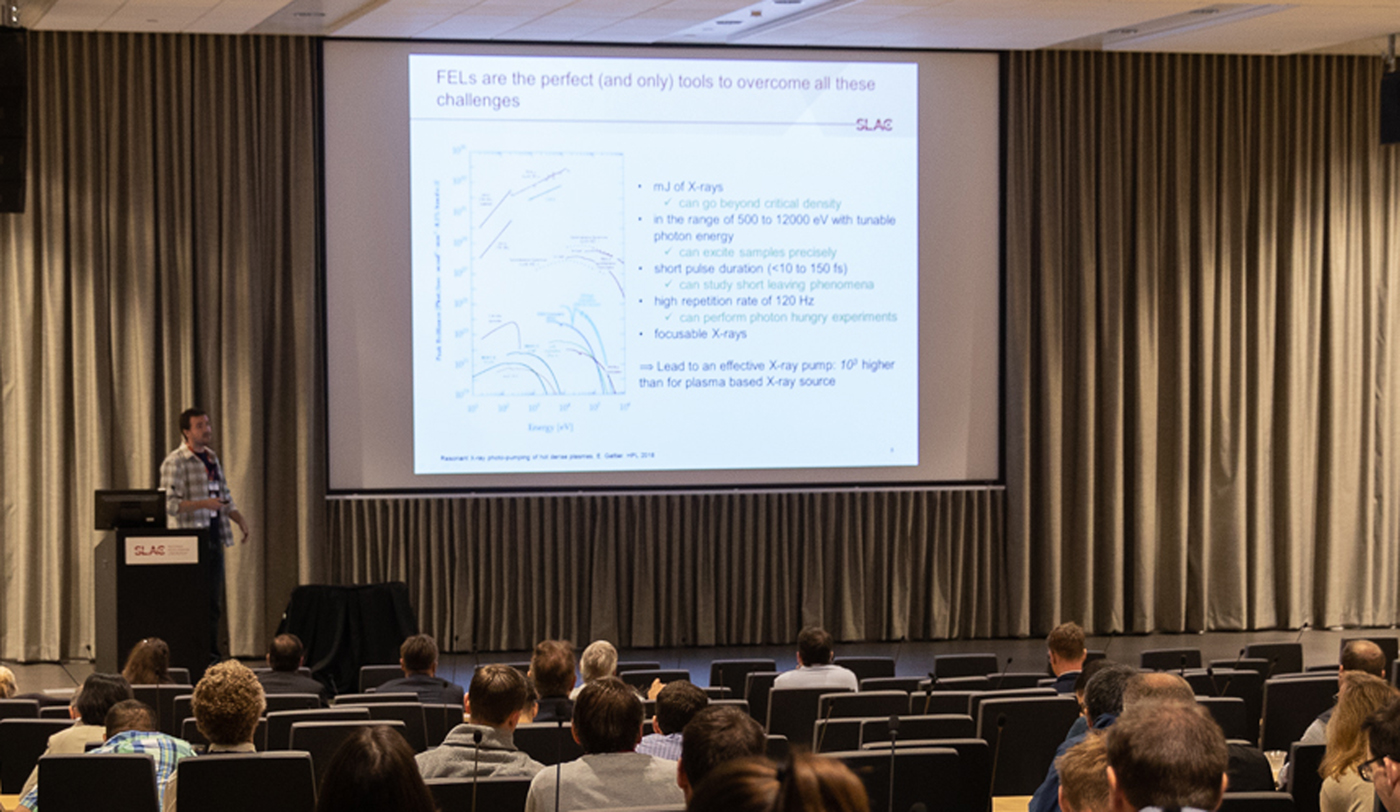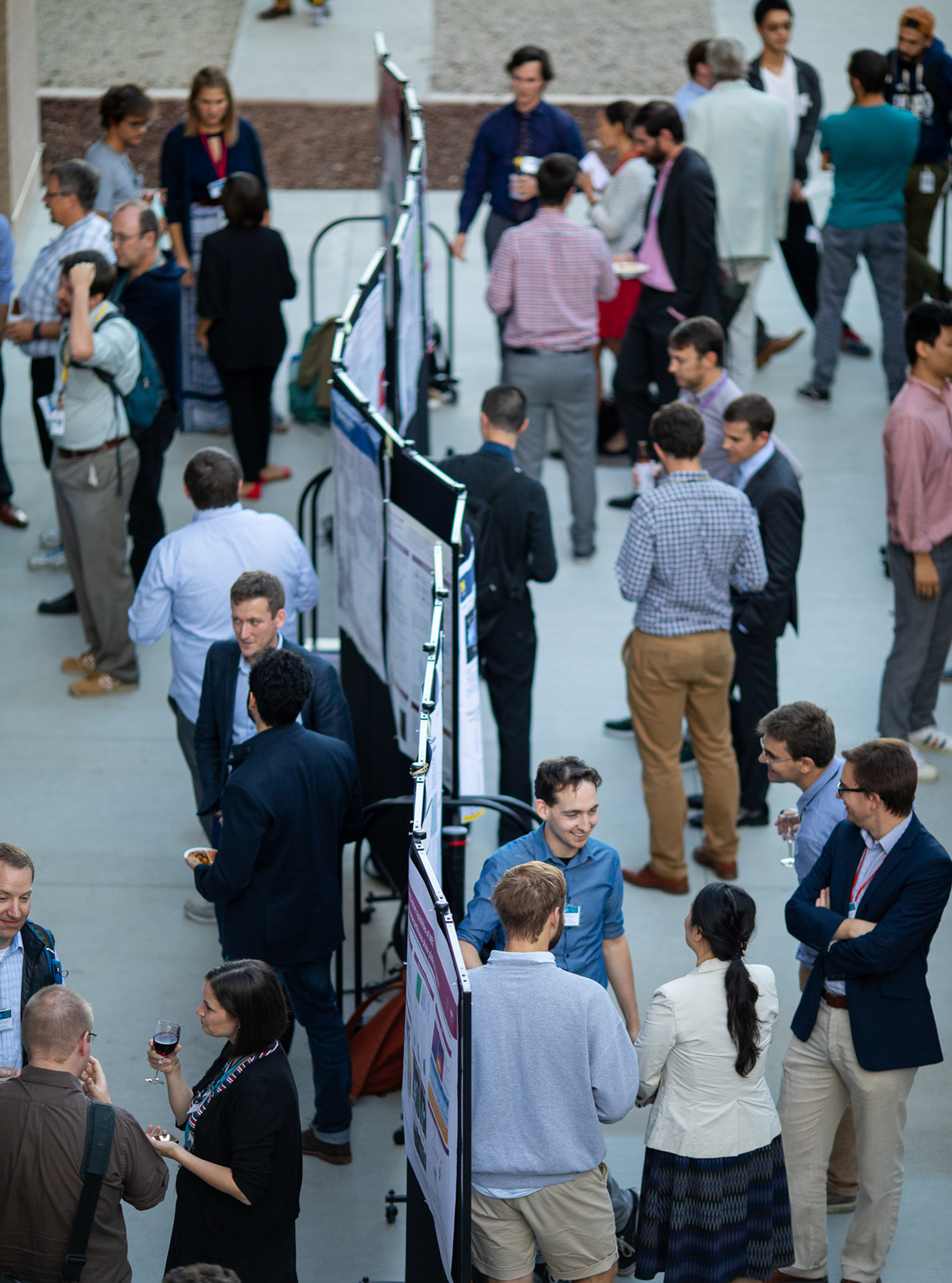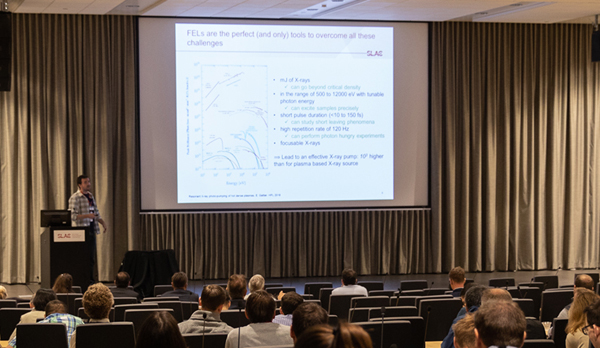The international user workshop on High-Power Lasers at the Linac Coherent Light Source (LCLS) was held at SLAC National Accelerator Laboratory (SLAC) in Menlo Park, CA, on September 25-26, 2018. More than 100 scientists attended the workshop, which focused on recent experiments and developments at the LCLS – Matter in Extreme Conditions (MEC) end station and, more generally, the scientific frontiers that can be explored using the combination of high-power lasers and the LCLS hard X-ray free electron laser (XFEL). This workshop was the sixth annual meeting in a series that has promoted information exchange between users and has provided recommendations on capability upgrades at LCLS-MEC (Falcone et al., Reference Falcone, Glenzer and Hau-Riege2014; Heimann and Glenzer, Reference Heimann and Glenzer2015; Bolme et al., Reference Bolme, Glenzer and Fry2016; Bolme et al., Reference Bolme, Mackinnon and Glenzer2017, Reference Bolme, Galtier and Glenzer2018) (Photo 1). In the last year, 11 journal articles have been published from research at LCLS-MEC (Brown et al., Reference Brown, Hashim, Gleason, Galtier, Nam, Xing, Fry, MacKinnon, Nagler, Granados and Lee2017; Gleason et al., Reference Gleason, Bolme, Lee, Nagler, Galtier, Kraus, Sandberg, Yang, Langenhorst and Mao2017; Kluge et al., Reference Kluge, Rödel, Rödel, Pelka, McBride, Fletcher, Harmand, Krygier, Higginbotham, Bussmann, Galtier, Gamboa, Garcia, Garten, Glenzer, Granados, Gutt, Lee, Nagler, Schumaker, Tavella, Zacharias, Schramm and Cowan2017; Kraus et al., Reference Kraus, Vorberger, Pak, Hartley, Fletcher, Frydrych, Galtier, Gamboa, Gericke, Glenzer, Granados, MacDonald, MacKinnon, McBride, Nam, Neumayer, Roth, Saunders, Schuster, Sun, van Driel, Döppner and Falcone2017, Reference Kraus, Hartley, Frydrych, Schuster, Rohatsch, Rödel, Cowan, Brown, Cunningham, van Driel, Fletcher, Galtier, Gamboa, Laso Garcia, Gericke, Granados, Heimann, Lee, MacDonald, MacKinnon, McBride, Nam, Neumayer, Pak, Pelka, Prencipe, Ravasio, Redmer, Saunders, Schölmerich, Schörner, Sun, Turner, Zettl, Falcone, Glenzer, Döppner and Vorberger2018; Wehrenberg et al., Reference Wehrenberg, McGonegle, Bolme, Higginbotham, Lazicki, Lee, Nagler, Park, Remington, Rudd, Sliwa, Suggit, Swift, Tavella, Zepeda-Ruiz and Wark2017; Bae et al., Reference Bae, Zastrau, Chung, Bernstein, Cho, Dyer, Galtier, He, Heimann, Kang, Kim, Kim, Lee, Lee, Nagler, Thomas and Cho2018; McBride et al., Reference McBride, White, Descamps, Fletcher, Appel, Condamine, Curry, Dallari, Funk, Galtier, Gauthier, Goede, Kim, Lee, Ofori-Okai, Oliver, Rigby, Schoenwaelder, Sun, Tschentscher, Witte, Zastrau, Gregori, Nagler, Hastings, Glenzer and Monaco2018; Seiboth et al., Reference Seiboth, Fletcher, McGonegle, Anzellini, Dresselhaus-Cooper, Frost, Galtier, Goede, Harmand, Lee, Levitan, Miyanishi, Nagler, Nam, Ozaki, Rödel, Schropp, Spindloe, Sun, Wark, Hastings, Glenzer and McBride2018; Sliwa et al., Reference Sliwa, McGonegle, Wehrenberg, Bolme, Heighway, Higginbotham, Lazicki, Lee, Nagler, Park, Rudd, Suggit, Swift, Tavella, Zepeda-Ruiz, Remington and Wark2018; Williams et al., Reference Williams, Künzel, Daboussi, Iwan, Gonzalez, Boutu, Hilbert, Zastrau, Lee, Nagler, Granados, Galtier, Heimann, Barbrel, Dovillaire, Lee, Dunn, Recoules, Blancard, Renaudin, de la Varga, Velarde, Audebert, Merdji, Zeitoun and Fajardo2018), and a total of 35 articles have been published since 2014.

Photo 1. (Color online) Participants of the Sixth High-Power Laser Workshop at SLAC National Accelerator Laboratory.
The workshop began with an introduction by Chi-Chang Kao, the SLAC director, followed by Kramer Akli, the program manager in the Department of Energy (DOE) – Fusion Energy Sciences (FES) that supports the MEC end station. Akli discussed the mission of his office, which is to build the scientific foundations needed to develop a fusion energy source and to expand the fundamental understanding of matter at very high temperatures and densities. This mission is supported by FES's commitment to invest in science, facilities, users, and the workforce. In fiscal year (FY) 2018, FES partnered with Lawrence Livermore National Laboratory (LLNL) in funding an upgrade to the Jupiter Laser Facility lasers. In FY2019, FES will support an upgrade to the Berkeley Lab Laser Accelerator laser at Lawrence Berkeley National Laboratory for a dedicated solid target interaction chamber with higher intensity focusing, resulting in better capabilities for high energy density (HED) science. Akli also announced the formation of LaserNetUS, a network of high-energy and high-intensity laser facilities across the USA. FES will begin supporting LaserNetUS with $3.4 M per year with the desire of incorporating additional funding agencies as the program develops. LaserNetUS would address the recommendations from the 2002 workshop on The Science and Applications of Ultrafast, Ultraintense Lasers (Ditmire and DiMauro, Reference Ditmire and DiMauro2002) and the 2017 study by the National Academies of Sciences, Engineering, and Medicine on Opportunities in Intense Ultrafast Lasers (National Academies of Sciences, 2018). The first LaserNetUS workshop was held in August 2018, and additional information on this initiative should be available soon. In concluding, Akli asked the audience to consider requirements for the next major laser capability in the USA, including the possibility of collocating this capability at LCLS as an upgrade to MEC.
I. RECENT EXPERIMENTS AT LCLS-MEC
The experiments performed at LCLS-MEC in the last year were presented by the users. Here we present the experiments thematically rather than in the order presented, starting with compression experiments. Yu Lin (SLAC) presented on the experiment she led investigating shock-compressed phase transitions in variants of diamondoids. This experiment follows static high-pressure experiments (Yang et al., Reference Yang, Lin, Baldini, Dahl, Carlson and Mao2016), and it shows variations in the responses as a result of polymorphism and the Carbon:Hydrogen ratio of the crystals. Martin Gorman (LLNL) presented his team's studies of the complex phase diagram of elemental calcium. He noted a sporadically occurring glitch in the delivered pulse shapes that would cause a divot or spike to arise, reducing the quality of affected shots. This irregularity arises from a known issue with the new pulse driver installed in the compression laser upgrade, which is now being addressed with an additional active feedback procedure developed at MEC. Alessandra Benuzzi-Mounaix (Laboratoire pour l'Utilisation des Lasers Intenses (LULI)) performed an experiment studying the structural response of silicates to shock and double-shock compression. These experiments also included recovery of some of the specimens for post-mortem comparison with mineralogical materials. Richard Sandberg (Los Alamos National Laboratory (LANL)) spoke about the challenges and successes in coherent diffractive imaging (CDI) at LCLS-MEC. One experiment that he highlighted had difficulties with reconstructing the dynamic images because of instability in the pointing of the X-ray beam and limited dynamic range of the X-ray detector. A later experiment showed a marked improvement in data quality from the addition of compound refractive lenses in the X-ray Transport Tunnel. Tom Duffy (Princeton University) presented on shock-compression experiments on carbide materials and on silicates. The silicate data are in good agreement with recent results using gas guns on slower time scales at the Dynamic Compression Sector at the Advanced Photon Source.
Several experiments made good use of the short pulse laser, including several operating in the new uncompressed (150 ps) mode. Eric Galtier (SLAC) led an experiment that performed resonant X-ray photo-pumping of hot dense plasmas (Photo 2). This experiment exploited the extreme brilliance and exquisite spatial, temporal, and spectral precision of LCLS to study the detailed atomic properties of dense copper plasma inside a laser generated plasma plume. Frank Rosmej (Sorbonne University) presented an experiment using the same target platform, but with precise scanning of the photon energy in self-seeded mode (ΔE = 0.5 eV), to investigate photon absorption and reemission in iron plasmas. This experiment addresses inconsistencies with solar opacities (Bailey et al., Reference Bailey, Nagayama, Loisel, Rochau, Blancard, Colgan, Cosse, Faussurier, Fontes, Gilleron, Golovkin, Hansen, Iglesias, Kilcrease, MacFarlane, Mancini, Nahar, Orban, Pain, Pradhan, Sherrill and Wilson2014). The narrow bandwidth and precise tuning of the seeded LCLS X-ray beam were required to pump specific transitions and to resolve the profile of X-ray peaks. Farhat Beg (University of California, San Diego) spoke about an experiment to measure proton stopping power in the warm dense matter. This experiment used the high-intensity optical laser at LCLS-MEC to accelerate protons from flat or hemispherical targets, which then heated a secondary foil that was probed by LCLS. Beg showed high-quality ion spectra but noted the significant difficulty in the alignment of the laser to target, particularly in the case of hemispheres, despite the aid from X-ray backlighting by LCLS. Maxence Gauthier (SLAC) presented X-ray diffraction (XRD) and phase contrast imaging (PCI) measurements of warm dense silica that was created using isochoric heating by optical laser generated protons in a similar experimental platform. Emma McBride (SLAC) presented measurements of transport properties using high-resolution inelastic X-ray scattering. An energy resolution of 50 meV was achieved using the 4-bounce channel-cut (533) Si monochromator together with diced silicon (533) crystal analyzers (McBride et al., Reference McBride, White, Descamps, Fletcher, Appel, Condamine, Curry, Dallari, Funk, Galtier, Gauthier, Goede, Kim, Lee, Ofori-Okai, Oliver, Rigby, Schoenwaelder, Sun, Tschentscher, Witte, Zastrau, Gregori, Nagler, Hastings, Glenzer and Monaco2018). This was used to measure the longitudinal acoustic phonon modes in warm dense Argon created by the interaction of the uncompressed short pulse laser (1 J, 130 ps) with a cryogenic Argon jet. Luke Fletcher (SLAC) presented XRD data on the structure of crystallized hydrogen, which has implications for laser-driven fusion using targets with deuterium-tritium ice. Haeja Lee (SLAC) presented an X-ray only isochoric heating experiment, in which she used the nano-focused LCLS to create and simultaneously probe high-temperature solid-density iron plasmas. The nano-focus was produced at CXI using twin Kirkpatrick Baez (KB) mirrors, precisely aligned using Ronchi interferometry (Nagler et al., Reference Nagler, Aquila, Boutet, Galtier, Hashim, Hunter, Liang, Sakdinawat, Schroer, Schropp, Seaberg, Seiboth, van Driel, Xing, Liu and Lee2017).

Photo 2. (Color online) Physicist Eric Galtier presented plasma science that can only be achieved using a tool such as LCLS combined with high power lasers.
II. NEW DIRECTIONS FOR X-RAY FREE ELECTRON LASERS
Thomas Tschentscher (European XFEL) presented an update of the European XFEL that achieved first light in 2017. The European XFEL consists of a high repetition rate superconducting linac with X-ray generation up to 25 keV (fundamental). The HED end station has a 200 TW optical laser that will be installed soon and a 100 J optical laser that will be delivered in the first quarter of 2019 (expected commencement of user experiments in 2020).
Gilbert Collins (University of Rochester) provided an overview of HED science with an emphasis on the drastic changes in the understanding of high-pressure material complexity that have occurred in the last decade. Traditional physics expectations were that materials became relatively simple at HED conditions (i.e. simple crystal structures, simple melt curves, and simple metals). However, recent research has shown that crystal and electronic structures become complex when core electron orbitals interact (i.e. complex crystal structures and formation of exotic electronic states, like electrides). XFELs will allow measurements of these structures when they are coupled to laser drivers that will achieve multi-megabar pressures.
III. LCLS UPDATE
LCLS Director Mike Dunne provided an update on the facility. In the last year, LCLS has demonstrated a 10 × decrease in minimum pulse width and a 3 × increase in X-ray peak power (Guetg et al., Reference Guetg, Lutman, Ding, Maxwell, Decker, Bergmann and Huang2018). Additional developments in pulse timing have demonstrated the potential to produce up to 8 X-ray bunches with sub-nanosecond spacing.
The LCLS-II upgrade is approximately 75% complete, and LCLS will be turned off for all of 2019 to allow for the final implementation of the upgrade. When the facility restarts in 2020, it will have two new variable gap undulators, one for soft X-ray and one for hard X-ray, both of which will be serviced initially with the current 120 Hz copper linac. MEC and the hard X-ray instruments will see higher maximum photon energy of 25 keV in the fundamental. The superconducting linac, set to deliver first light in early 2021, will enable soft and tender X-rays at continuous MHz repetition rates to be delivered to the newly upgraded soft X-ray instruments.
IV. MEC STATUS AND OUTLOOK
MEC Department Head Gilliss Dyer presented the status and plans for the MEC instrument with the vision of developing a world-leading HED program in combination with a free electron laser.
MEC received an upgrade to the long-pulse optical laser during FY2017, which included transitioning to a diode-pumped front end, 25 mm glass amplifiers (1 J with a repetition rate of 1 shot/2 min), and 50 mm glass amplifiers (60 J with a repetition rate of 1 shot/7 min). In FY2018 the standard configuration was upgraded to take better advantage of the new laser energies, with shallower coupling angles to target, improved focusing optics, and new continuous phase plates (CPP). With the new configuration, uniaxial shock pressures exceeding 3 Mbar were demonstrated during laser-only experiments before run 17.
MEC has two new operating modes available with the short pulse optical laser: uncompressed and 2ω (400 nm with improved pre-pulse contrast), both of which were used successfully in a number of experiments during runs 15 and 16. A completely new pulse cleaner was installed in FY 2018, bringing excellent contrast with little to no tuning required and greatly improving operational efficiency. The primary challenge with the short pulse laser in the past year was damage in the laser from target back-reflections. The damage was most severe when the compressor was bypassed and when the experimental configuration had the target geometry near normal incidence with respect to the optical laser, particularly with solid metal targets. As a temporary measure to protect the laser, the target surface is now being required to be at ≥45° from the incident laser direction. A system is now being designed to remove residual gain from the Ti:Sapphire amplifiers to prevent back reflections from amplifying.
A new transmission crystal spectrometer has been introduced at MEC, providing straightforward alignment, a broad spectral range, and better shielding from X-ray background. The spectrometer was commissioned during Eric Galtier's experiment.
During the LCLS shutdown in 2019, the MEC lasers will be active. MEC will support a limited number of laser-only user-collaborative experiments, including one to two experiments awarded through the first LaserNetUS call for proposals in early February 2019. Additionally, the following improvements in operational efficiency will be pursued: better-automated pulse shaping, motorization/stabilization of key mounts, an upgraded laser diagnostic suite, new standard delivery platforms, and an electromagnetic pulse (EMP) mitigation campaign.
Future capability upgrade options are being explored that would rebuild the end of the currently existing tunnel of the far experimental hall (FEH), doubling the space available to MEC, to allow the installation of permanent radiation shielding and a petawatt-class laser. Additionally, larger upgrade options involving the construction of an external laser building adjacent to MEC are under serious consideration. Such a building would be constructed to allow future upgrades beyond an initial petawatt short pulse and >100 J long pulse laser. In all cases, construction for the new MEC capabilities would be coordinated with scheduled down times of LCLS in the years after 2019.
V. DISCUSSION OF SCIENCE ENABLED BY A LASER CAPABILITY UPGRADE
The workshop discussion session focused on the exciting scientific frontiers that could be explored with a significant increase in laser capabilities at LCLS. To fully explore the physics phase space of interest to fusion energy sciences, the community requested laser capabilities with increased laser power and energy. The former should deliver beam intensities of more than 1021 W cm−2 to drive secondary radiation sources (e.g. betatron radiation for X-ray pump – X-ray probe studies). In addition, laser-produced proton jets and neutron beams were discussed for studies of radiation damage in materials, isochoric heating for warm dense matter experiments, and directly studying fusion processes. Additional opportunities include studies in areas related to quantum electrodynamics (QED), laboratory astrophysics, and atomic physics. For these studies, short laser pulses in the range of 10–100 fs are desired. In addition, possible upgrades in laser energy were discussed with the goal to reach pressures that exceed 10 Mbar. For these upgrade options, versatile experimental capabilities with high repetition rate would be beneficial to serve a broad user community, to achieve the best scientific results, and to take advantage of new developments in machine learning.
VI. POSTER AWARDS
The poster awards were sponsored by Instruments, an open access journal by MDPI. The poster award winners were Amy Coleman (University of Edinburgh) for Dynamic and Static Compression of Antimony, Chandra Curry (University of Alberta and SLAC) for Laser-driven Ion Acceleration from Cryogenic Low-Z Jets, and Nicholas Hartley (Helmholtz-Zentrum Dresden-Rossendorf) for Carbon-Hydrogen Demixing and Hydrogen Metallization. (Photo 3)

Photo 3. (Color online) Participants of HPL-6 discuss their work at the poster session.
FUNDING
Workshop funding was provided by the DOE Office of Science – Fusion Energy Sciences under contract FWP 100189.
We are grateful for the support of the corporate workshop sponsors: Amplitude, General Atomics, Lattice Electro Optics, National Energetics, Phasics, and Prism Computational Sciences. The poster award was sponsored by Instruments, an open access journal by MDPI. Additional support was provided by SLAC National Accelerator Laboratory, Stanford University, and Los Alamos National Laboratory.
Acknowledgements
We also gratefully acknowledge conference planning and administrative support from Nitssia Harrison, Christine Soldahl, Regina Franco, Glenna Paige, Charlotte Hee, and Jimmy Pham. Photos by Dawn Harmer.
Additional information may be obtained at the workshop website: https://conf.slac.stanford.edu/hpl-2018/





